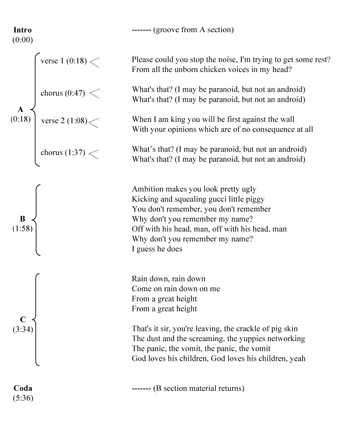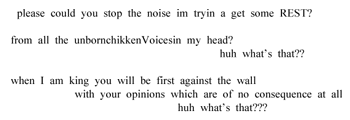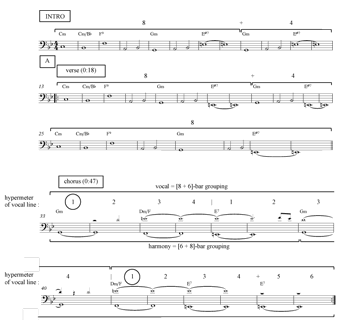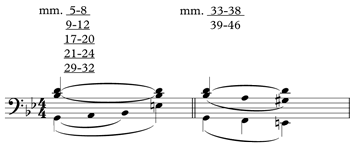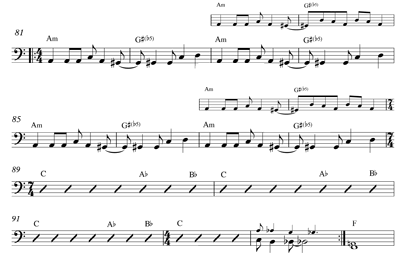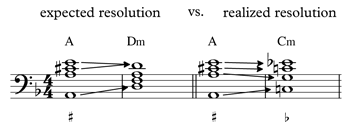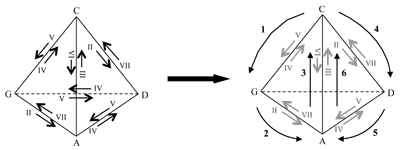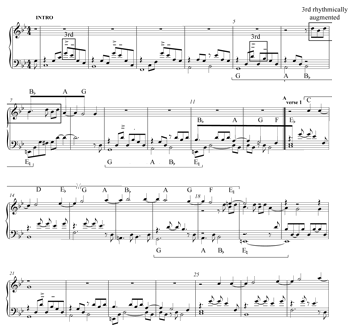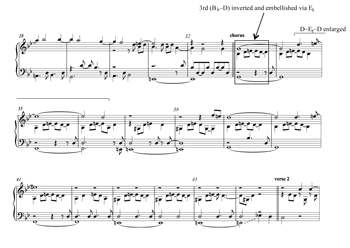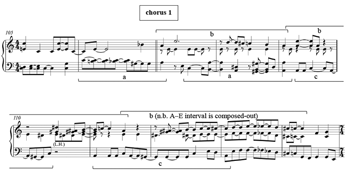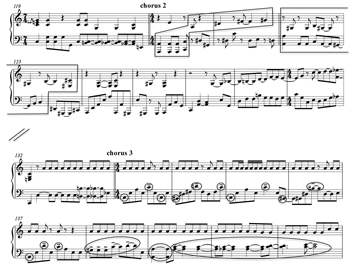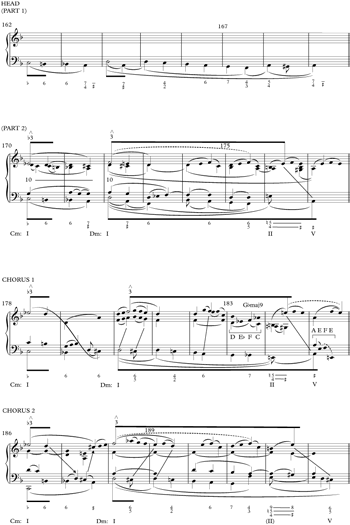Crossing Over with Brad Mehldau’s Cover of Radiohead’s “Paranoid Android”: The Role of Jazz Improvisation in the Transformation of an Intertext *
René Rusch
KEYWORDS: Brad Mehldau, Radiohead, intertextuality, jazz improvisation, cover songs
ABSTRACT: This paper explores the intertextual relationships between popular music songs and their jazz adaptations, or “covers.” In a jazz adaptation of a pop song, the improvisatory section—wedged between two more or less complete statements of the pop song—forms the crux of the jazz performance. Improvisation affords musicians an opportunity to create something new out of an existing musical work and, as I suggest in this paper, has the potential to transform the expression perceived in the popular song’s lyrics and musical structure. Using Brad Mehldau’s live solo piano performance of Radiohead’s “Paranoid Android” (1997) from his promotional album Deregulating Jazz ([1999] 2000) as a case in point, I show how his adaptation both highlights the motivic repetitions in the original rock song and heightens the song’s expressions of anxiety and apprehension.
The article unfolds in two sections. The first section provides an overview of Radiohead’s “Paranoid Android” as a means to ground my discussion of Mehldau's recording. Here I consider how the rock song’s musical content can be heard as the analog of its lyrical content. In the second section, I explore the intertextual relationships that emerge between Mehldau's adaptation and Radiohead's rock song, drawing from my transcriptions and analyses of both musical texts.
Copyright © 2013 Society for Music Theory
[1.1] Within the last fifteen years, cover songs have provided fertile ground for exploring intertextuality in popular music, and how meaning can differ amongst repetitions of the same musical “text.”(1) Lori Burns (1997), for instance, has shown how k.d. lang’s live performance (1985) of Joanie Sommer’s “Johnny Get Angry” (1962) transforms the teen-heartache love song into one about abuse through physical gestures, rhythmic distortion, and changes in the musical structure, inviting listeners to rethink the power dynamics between men and women. In a similar vein, Mark Butler (2003) has suggested that The Pet Shop Boys’ disco cover (1991) of U2’s “Where the Streets Have No Name” (1987) critiques the ways in which rock musicians had constructed authenticity in the 1980s. As Butler proposes, The Pet Shop Boys’ effortless vocal delivery, use of synthetic sounds, and subversion of pitch and formal structures function as a foil to musical attributes that served as markers of authenticity, such as laboured vocals, the avoidance of musical loops created through technology, and a clear formal development.
[1.2] One question that has received less attention in studies on intertextuality is how a jazz adaptation of a popular song can affect the song’s poetic content. When jazz musicians “cover” a popular song, how might a solo improvisation alter or enhance the pop song’s potential meanings, particularly in cases where the poetic text no longer serves as the focus of the performance?(2) As Henry Martin and Keith Waters (2010) confirm, it is not unusual for jazz musicians to crossover to popular music genres:
Numerous jazz artists are experimenting with the song repertory of the early 1960s and later as a means of expanding the traditional jazz focus on the great popular standards of 1920–1950. Artists are experimenting with tunes by numerous rock groups, including the Beatles; the Grateful Dead; Bjork; Nirvana; Radiohead; Sly and the Family Stone; Crosby, Stills, Nash & Young; and the Doors. (367)
Elements that distinguish popular music covers from jazz adaptations are not only differences in musical style, but also the addition of one or more improvised solos that take place after the initial presentation of the pop song. Analogous to a “head” in jazz practice, the initial presentation introduces the melody, musical form, and harmonic progressions or “changes” that serve as the basis for the improvised solo section.(3) During the solo section, jazz musicians may embellish the pop song’s pitch and rhythmic content, compose their own melodic material over the harmonic progressions, or modify the progressions through a number of chord substitutions.(4) Following an improvised solo section is a recapitulation of the entire pop song or a portion thereof that rounds off the performance. In a jazz adaptation of a popular music song, then, the improvisatory section—wedged between two more or less complete statements of the pop song—forms the crux of the jazz performance: it affords musicians an opportunity to create something new out of an existing musical work and, as I suggest in this paper, has the potential to alter the expression perceived in the popular song’s lyrics and musical structure.
[1.3] Before moving ahead in my discussion, I would like to clarify what I mean by intertext. Whereas Michael Riffaterre defined the term as a “corpus of texts, textual fragments, or textlike segments of the socialect that shares a lexicon and
[1.4] To explore the role that improvisation can play in intertextual readings of jazz adaptations, I will use Brad Mehldau’s live solo piano performance of Radiohead’s “Paranoid Android” (1997) from his promotional album Deregulating Jazz ([1999] 2000) as a case in point.(7) Since his album debut in 1995, Mehldau has garnered attention not only for revamping jazz standards in unconventional time signatures, such as Richard Rodgers’s “I Didn’t Know What Time It Was” in
[1.5] This article unfolds in two sections. The first section provides an overview of Radiohead’s “Paranoid Android” as a means to ground my discussion of Mehldau’s recording. Here I consider how the rock song’s musical content can be heard as the correlate of its lyrical content. In the second section, I explore the intertextual relationships that emerge between Mehldau’s adaptation and Radiohead’s rock song, drawing from my transcriptions and analyses of both musical texts. Appendix 1 provides a transcription of the beginning of Radiohead’s recording from Ok Computer, and Appendix 2 provides a complete transcription of Mehldau’s version from Deregulating Jazz.
Analysis of Radiohead’s “Paranoid Android”
Example 1a. Radiohead‘s “Paranoid Android,” OK Computer (1997), lyrics and form
(click to enlarge)
[2.1] “Paranoid Android” was composed and recorded by the alternative rock band Radiohead and appears on their widely acclaimed album OK Computer (1997).(9) As Radiohead critics and fans point out, the title of the rock song references the fictional character “Marvin the Paranoid Android” from Douglas Adams’s 1978 BBC radio comedy series The Hitchhiker’s Guide to the Galaxy, which was later adapted into a series of books. Unlike Adams’s comedic portrayal of the depressed robot Marvin, however, Radiohead’s “Paranoid Android” appears to depict a socially alienated and anxiety-ridden persona surrounded by a society consumed by the trappings of capitalism––one of several themes that the album explores. Power (“When I am king”) and materialism (“gucci”; “yuppies”) generate self-importance (“Why don’t you remember my name”) and excess (“piggy”), threatening to consume, impair, and silence (“With your opinions which are of no consequence at all”) in the desire for more (Example 1a). The fear and realization that the capitalist machine has participated in the formation of the subject and created, as a condition of possibility, the potential to equate the valuation of material goods with identity and self-worth, provokes a split subject––a “paranoid android” who recognizes that its individual thoughts and ambitions may also be a product of the capitalist machine (“Please could you stop the noise
Example 1b. Radiohead‘s “Paranoid Android,” OK Computer (1997), typography of lyrics from the CD booklet (A section)
(click to enlarge)
[2.2] Nadine Hubbs’s description of the lyrics from Radiohead’s Ok Computer as “already oblique in their written form
[2.3] The music of “Paranoid Android” contributes to the lyrics’ expression of fragmentation, antithesis, and anxiety. Written for voice, acoustic and electric guitars, Mellotron, and percussion, the rock song contains several features that prevent it from achieving a state of rest: (1) a through-composed form comprised of three discrete sections––A (0:18), B (1:58), and C (3:34)––that are framed by an introduction (0:00) and a coda (5:39) (see Example 1 again);(11) (2) tonal pairing within each formal section, where one of two possible tonics prevail at a given time;(12) and (3) shifts in texture, tempi, and meter. Radiohead’s bassist Colin Greenwood has acknowledged that “Paranoid Android” fuses together individual compositions (Jabba 1998), and indeed each main section features its own motives, phrase rhythm, and tonal areas. Collectively, the three main sections in the through-composed form might be best described as a musical “triptych” or montage of discrete fragments that resist forming a unified whole.(13)
Example 2a. Radiohead, “Paranoid Android,” intro and A section (measures 1–46), composite sketch
(click to enlarge and listen)
Example 2b. Harmonic variant, intro and A section
(click to enlarge)
[2.4] A main feature of both the introduction and the A section is that musical repetitions are either truncated or partially realigned. These varied repetitions can create an unsettling effect in the listening experience because they discourage the initial unit that precedes each repetition from achieving a sense of stability. The introduction, which establishes the groove for the A section, features a twelve-bar unit that can be subdivided into an eight-bar phrase and four-bar extension (Example 2a). Here the four-bar extension repeats the harmonic progression from the last four measures of the eight-bar phrase, encouraging us to rehear these last four measures as an initiating unit in the next four-bar group (c.f. measures 5–8 and 9–12).(14) The A section—in verse-chorus form—repeats the introduction’s twelve measures at the forefront of its first verse (measures 13–24), now with Yorke’s vocal line (“Please could you stop the noise I’m trying to get some rest”) added above. The second phrase in the first verse (“from all the unborn chicken voices in my head?”) presents a truncated version (measures 25–32), repeating the accompaniment from the first eight bars of the first phrase and omitting the four-bar extension. The grouping structure for the entire first verse can be summarized as
[2.5] An example of realignment occurs in the A section’s chorus (measures 33–46), which sounds a variant of the G minor → E half-diminished progression from the intro and first verse (see Example 2b). The two phrases that make up the chorus can be expressed both as
[2.6] The tonal pairing in the A section also contributes to the music’s unease. The first two measures of the introduction suggest that the piece will be in C minor, yet the swerve towards G minor in measures 4–5 calls into question the tonal hierarchy: Is C minor the tonic, or does C minor function instead as the subdominant (IV) of G minor? The ambiguity of the song’s tonal center continues in the A section, which opens with the same harmonic progression as the introduction. While the tonality appears to gravitate more towards G minor as the A section gets underway, this tonal center is weakened by a reappearing
Example 3. B section (1:58), transcription of bass and harmonic progression
(click to enlarge)
[2.7] Example 3 presents a transcription of the bass and harmonic progression at the beginning of the B section (1:58). There is a change in musical texture and mood, beginning with a driving syncopated A-minor riff in
Example 4a. C section (3:34), harmonic progression
(click to enlarge)
Example 4b. C section, resolution of A-major triad at boundary point
(click to enlarge)
[2.8] The C section (3:34) opens with a slow eight-bar harmonic progression that functions as a ground bass, with vocal dubbing and electronic vocal patches layered above Yorke’s non-syllabic vocal line. As the voice-leading sketch shows (Example 4a), the eight-bar progression features two descents, the first in C minor and the second in D minor. The first descent, which can be heard as a variant of the descending chromatic bass line that adjoins the double-tonic complex A minor and C major in the B section, resembles a baroque lament bass line. Here its implied descent to G is interrupted via a harmonic reinterpretation of the B-flat and A that support a G-minor ![]()
![]()
![]()
Example 5a. Tonal regions in “Paranoid Android,” Radiohead, OK Computer (1997)
(click to enlarge)
Example 5b. Matrix of tonal relationships
(click to enlarge)
[2.9] Example 5a summarizes the tonal pairing that occurs throughout “Paranoid Android.”(16) The intro and A section juxtapose C minor and G minor, the B section—A minor and C minor, the C section—C minor and D minor, and the coda—A minor and C major. The solid arrow indicates a change in scale-step between sections and the dotted arrow, a change of mode. Each section in the through-composed form juxtaposes two competing tonics, creating a sense of tension in the listening experience. The tonic, as a potential state of rest, is constantly stymied, forcing the listener to repeatedly reconfigure the tonal hierarchy throughout the song. The matrix in Example 5b clarifies the hierarchical relationships between all four competing tonics, and Example 5c maps this matrix of tonal relationships on a tetrahedron, marking the pathway traversed in “Paranoid Android.” This tonal pathway—summarized as C–G–A–C–D–A–C—is not unidirectional, but rather fluctuates between tonic pairs within each section.
|
Example 5c. Summary of the tonal pathway in “Paranoid Android” (click to enlarge) |
Walter Everett’s (2008) description of popular music that subverts monotonality seems especially fitting for the tonal disposition of “Paranoid Android”:
Some songs are structurally diatonic and depend on normal tonal chord progressions, and yet no single overriding tonal center can be appointed conclusively because the song’s various formal sections revolve around separate tonics (perhaps in pairs suggesting the double-tonic complex of Bailey 1977) and closure is not provided by any overall directed voice leading. (145)
In “Paranoid Android,” a group of adjacent chords on the local level may appear to gravitate towards a single tonic against a diatonic background, allowing one to interpret the tones within these chords as adhering to the principles of strict voice leading. When taken together, however, the groups of chords reveal multiple tonics that project a disjointed tonal structure, obfuscating the possibility that a unified contrapuntal structure governs the unfolding of the rock song’s peculiarities.(17)
Analysis of Mehldau’s Adaptation of “Paranoid Android”
[3.1] While Mehldau’s performance of “Paranoid Android” closely adheres to the pitches and rhythms in Radiohead’s recording, the change in instrumentation and two improvised solos over the B and C sections’ harmonic structure mark extensive points of departure.
Re-instrumentation for solo piano
[3.2] In his adaptation of “Paranoid Android” for solo piano, Mehldau weaves the pitches and rhythms sounded by the voice, acoustic and electric guitars, and electric bass into a contrapuntal tapestry (Compare Appendix 1 to Appendix 2). The pitch content in the intro (originally played by the acoustic and electric lead guitar) unfolds in four layers or “voices”—tenor, bass, accompaniment, and countermelody––which collectively form a composite rhythm of steady eighth and quarter notes. To differentiate between the first three voices, Mehldau situates the tenor and bass on the registral outskirts of the arpeggiated accompaniment and slightly accentuates both the tenor’s syncopated major thirds and the bass line. The fourth voice, or countermelody (measures 6–8) (originally played by Jonny Greenwood on lead guitar) enters above the first three voices in Mehldau’s adaptation. At the onset of the A section (measure 13), Mehldau adds a fifth layer, the syncopated melody initially sung by Yorke. By positioning the vocal melody an octave higher than Radiohead’s recording, he distinguishes this layer from the remaining four throughout the A section.
Example 6a. Mehldau, transcription of “Paranoid Android,” measures 1–24: Motivic repetitions in the intro and A section
(click to enlarge and listen)
Example 6b. Mehldau, transcription of “Paranoid Android,” measures 33–38: Motivic repetitions in the intro and A section
(click to enlarge)
[3.3] Emerging from Mehldau’s articulation of this five-tiered pitch and rhythmic structure is a dialogue amongst the voices that underscores the forms of motivic repetition in Radiohead’s recording. Examples 6a and 6b trace how two central motives in both the intro and A section—the descending major third and the melodic line G–A–
[3.4] Mehldau’s arrangement thus makes the relationship between figure and ground, or vocal line and accompaniment, more complex compared to Radiohead’s recording. By folding together the pitch and rhythmic material under one solo instrument and by elevating the countermelodies and bass to a more substantial role through articulation and dynamics, the motivic repetitions in the layered dialogue become more prominent within the contrapuntal texture.
Solo Sections
[3.5] The repetition of the B and C sections’ harmonic structure in Radiohead’s recording creates an opportunity for two improvised solos. What is remarkable about both of Mehldau’s solos is that he mostly preserves the contrapuntal layers of the individual lines established in the intro and A section, while also using the musical contents from each section as points of departure. Mehldau prefaces each solo with the composed material heard in Radiohead’s recording, which functions as a “head” (see Appendix 2, B section (measures 81–106) and C section (measures 162–77)). This musical material introduces the themes and harmonic progressions, and it serves as the scaffolding upon which Mehldau builds his improvisation. As my analysis below suggests, his approach towards developing the musical content in both solo sections follows a similar narrative––from lucidity to disorder. I trace these transformations in each solo and then explore how they transform the intertext upon which they are based.
Example 7a. Mehldau, motivic transformations, B section; motives are varied at overlapping time intervals (2:41)
(click to enlarge)
Example 7b. Mehldau, motivic transformations, B section; fragmentation of A-minor riff (motive c) via register transfer (3:01)
(click to enlarge)
[3.6] Mehldau begins his first solo over the B section by rhythmically augmenting and composing out motives in different voices at overlapping time intervals. The first phrase of his first “chorus” (measures 107–15) features three motives, labeled a–c in Example 7a:(18) (a) C–
[3.7] After Mehldau layers motivic variants on top of one another in his first chorus, he transposes portions of the A-minor riff (motive c) and places their fragments in different registers within the composite contrapuntal texture in his second and third choruses (Example 7b). At the onset of the second chorus (measure 120), he restates the first half of the A-minor riff in the bass and then transfers the second half in the alto register, altering the pitches of the riff (from
[3.8] The trajectory that the motivic development follows in Mehldau’s first solo––from overlapping layers of motivic variants to motivic fragmentation via register transfer––reaches its climax in his fourth chorus (measures 147–61). The A-minor riff in this final chorus is no longer recognizable in its complete form; in its place are sparse and abrupt dissonant chords that sporadically punctuate the driving eighth notes in the bass (see Appendix 2).
[3.9] In Mehldau’s second solo, which spans seven choruses, he gradually distorts the theme from the C section and alters its harmonic progressions. He begins the section by stating the “head,” which unfolds over two statements of the section’s harmonic progression (Appendix 2, measures 162–77). Similar to Radiohead’s recording, the first statement (measures 162–69; “part 1”) in Mehldau’s performance features a homophonic texture, wherein the upper voice generally doubles the bass. In the second statement (measures 170–77; “part 2”), Mehldau layers the primary melody (which corresponds to the vocal line “Rain down, rain down” in Radiohead’s recording) on top of this homophonic texture, forming parallel tenths with the bass. Notably, he retains the upper voice from part 1 and places it in the alto register, creating 9–8 suspensions with the bass (measures 170 and 172). Mehldau effects a seamless transition between a complete presentation of the head and his first chorus (measures 178–85) by adding a third voice in the soprano register, which sounds a variant of the primary melody. As with this first chorus and the three that follow, the primary melody is diffused amongst the layered voices, placed in different registers in the composite contrapuntal texture. Towards the end of his fourth chorus (measures 207–10) and into his fifth chorus, Mehldau dilutes the layered texture of voices to melody and accompaniment, shifting the listener’s focus to the harmonic reinterpretation of the bass line and its effects on the C-section’s primary melody.
Example 8. Voice-leading sketch of Mehldau‘s second solo (head + 7 choruses)
(click to enlarge)
[3.10] The voice-leading sketch in Example 8 traces Mehldau’s modifications to the bass-line progression throughout his solo improvisation. The process begins in his first chorus (measures 178–85), where a ![]()
![]()
![]()
[3.11] If Radiohead’s “Paranoid Android” functions as an intertext for listening to Mehldau’s adaptation, how might Mehldau’s arrangement and two solo improvisations affect our prior interpretation of the rock song? Mehldau’s adaptation communicates a similar aesthetic of fragmentation and antithesis because it preserves the tripartite form and tonal pairing within each section. Yet the marked differences in instrumentation––an acoustic piano, as opposed to a combination of electronic and acoustic guitars, Mellotron, percussion, and voice––and placement of the instrument(s) in the lateral scoundscape lends Mehldau’s recording a more introspective and introverted sound, compared to Radiohead’s. Sonic space seems more narrow in Mehldau’s recording because the piano’s sound is mostly located in the center of the stereo image. Conversely, in Radiohead’s recording, the vocal and instrumental lines are situated in different locations within the stereo image, creating the illusion of spatial depth.(19) If the notion of a persona is preserved in Mehldau’s recording, this timbral “reduction” may invite listeners to perceive this persona as more reclusive or introverted, or perhaps enable listeners to witness a more private, interior space of the persona.
[3.12] While the absence of lyrics during both solos deprive the improvised pitch and rhythmic material of semantic meaning, the ways in which Mehldau reinscribes the song’s motives and harmonic structure within both improvisations appear to heighten the song’s expressions of anxiety and apprehension. Whereas Radiohead develops the musical content in the B and C sections mostly through repetitions of central motives (e.g., A-minor riff) or melodies (“Rain down”), as well as through counter melodies that are layered on top of existing ones (“That’s it sir”), Mehldau gradually obscures the content in these sections by first presenting the motives and harmonic progressions intact and then by distorting them. In Mehldau’s first solo over the B section (measures 107–61), motives are tightly interlaced in overlapping segments within a contrapuntal texture, dispersed by means of register transfers, and then fractured. In his second solo (measures 162–233), melodic lines are moderately layered on top of one another, severed into fragments that appear in different registers, and then distorted through alterations of the ground-bass progression. Unlike Radiohead’s B and C sections, the gradual anamorphosis of the motives and harmonic progressions in Mehldau’s choruses over these two sections effects a marked perceptual change in expression––from stability to instability, or perhaps from order to chaos––which might be mapped onto the listener’s intertextual reading of “Paranoid Android” in any number of ways (as an analogue to either the persona’s perception of a society slowly deteriorating due to omnipotence and greed, for instance, or as an analogue to the split persona’s changing psychological state).
[3.13] The cyclic repetition of each section’s musical structure in both solos also plays a role in heightening the song’s expression of anxiety. If the unstable repetitions, tonal structure, and abrupt shifts in texture, tempi, and meter prevent the music from achieving a state of rest in Radiohead’s recording, the repetition of the musical structure during the gradual deformation of the motives and harmonic progressions in Mehldau’s two solos can create a sense of restriction or claustrophobia. Here the tonal pairing in each respective musical structure resists resolution, and the repetition of this musical structure only restates the tonal “problem” amidst further motivic decay in a seemingly endless cycle. That the cycle eventually becomes “warped” itself in the latter half of Mehldau’s second solo––where the boundary point between the end of the progression and its beginning gradually deteriorates by means of long stepwise descents that connect the D-minor descent to the C-minor one––alienates the melody from its very surroundings, consequently transforming it into a dissonant, grotesque form.
Conclusion
[4.1] In an interview for All About Jazz with columnist Fred Yung (2004), Mehldau questions whether the term “cover” accurately describes a jazz performance of a popular song:
AAJ: You’ve spawned instrumentalists doing Radiohead covers. Has Radiohead sent you a fruit basket?
BM: “Cover” is an unfortunate word—I guess it works pragmatically to describe an interpretation of a tune that hasn’t been around long enough to be deemed a “standard.” But “cover” also means just playing the tune—like you’re a wedding band and the bride says, “Can you guys play ‘We’ve Only Just Begun?’” and you cover it for them. You have to do something more with the tune if you want to transcend just doing a “cover” in that narrow definition of the word, and with us it’s through the interpretation of the melody and harmony, our rhythmic approach, and most importantly, the collective improvisation that ensues.
Mehldau’s response rightly captures the tension between fidelity and creativity––what Julie Sanders (2006) has also described as “the fundamental contradictory impulse towards dependence and liberation implicit in the majority of the adaptations and appropriations” (11). The term’s tendency to conceal the complex relationships that can occur between repetitions of the same musical text has led some music scholars to adopt different terms, such as “version” and “base song.”(20) These distinctions appear to point towards a larger concern, namely the prescriptive power that certain recordings can have over other recordings or live performances, wherein the recording itself, rather than a notated form of the song, can possess the authority to subordinate other versions to diminutive types: reproductions and copies.(21) The extent to which Radiohead’s recording of “Paranoid Android” holds such prescriptive authority over Mehldau’s adaptation can be put into question, however, when his improvisation is heard as the focal point of his performance; Radiohead’s “original” can function as an intertext that Mehldau’s “cover” acts upon, displacing the power relations between constructed hierarchies. As I have suggested in this paper, Mehldau’s adaptation has the potential to recontextualize Radiohead’s prior musical “utterances” and thus transform or nuance their possible meanings. The rock song’s signature motives and musical structures enter into a dialogue with the new, extemporized material that has the ability to change or color the “already-written,” encouraging us to rehear and rediscover the original through its cover.
René Rusch
McGill University
Music Theory, Dept. of Music Research
555 Sherbrooke Street West
Montreal, QC H3A 1E3
rene.rusch@mcgill.ca
Works Cited
Adams, Douglas. 1978. The Hitchhiker’s Guide to the Galaxy. BBC Radio 4.
Adams, Nathaniel E. 2011. “Open Coding OK Computer: Categorization and Characterization of Disruptive Harmonic and Rhythmic Events in Rock Music.” PhD diss., University of Michigan.
Bailey, Robert. 1969. “The Genesis of Tristan and Isolde and the Study of Wagner’s Sketches and Drafts for the First Act.” PhD diss., Princeton University.
—————. 1977. “The Structure of the Ring and Its Evolution.” 19th-Century Music 1, no. 1: 48–61.
—————. 1985. “An Analytical Study of the Sketches and Drafts,” in Prelude and Transfiguration from “Tristan and Isolde,” ed. Bailey, 113–46. New York: W.W. Norton.
Bloom, Harold. 1973. The Anxiety of Influence: A Theory of Poetry. New York: Oxford University Press.
Burns, Lori. 1997. “Joanie Get Angry: k.d. lang’s Feminist Revision.” In Understanding Rock: Essays in Music Analysis, ed. John Covach and Graeme M. Boone, 93–112. New York: Oxford University Press.
Butler, Mark. 2003. “Taking it Seriously: Intertextuality and Authenticity in Two Covers by the Pet Shop Boys.” Popular Music 22, no. 1: 1–19.
Coyle, Michael. 2002. “Hijacked Hits and Antic Authenticity: Cover Songs, Race, and Postwar Marketing.” In Rock Over the Edge: Transformations in Popular Music Culture, ed. Roger Beebe, Denise Fulbrook, and Ben Saunders, 113–57. Durham: Duke University Press.
Crawford, Richard. 2001. America’s Musical Life: A History. New York: W.W. Norton.
Everett, Walter. 1992. “Voice Leading and Harmony as Expressive Devices in Early Music of the Beatles: She Loves You.” College Music Symposium 32: 19–37.
—————. 2008. “Pitch Down the Middle.” In Expression in Pop-Rock Music: Critical and Analytical Essays, ed. Walter Everett, 111–74. New York: Routledge.
Genette, Gérard. (1982) 1997. Palimpsests: Literature in the Second Degree. Trans. Channa Newman and Claude Doubinsky. Lincoln: University of Nebraska Press. Originally published Palimpsestes: La Littérature au Second Degré. Paris: Seuil.
Hubbs, Nadine. (2000) 2008. “The Imagination of Pop-Rock Criticism.” In Expression in Pop-Rock Music: A Collection of Critical and Analytical Essays, ed. Walter Everett, 215–37. 2nd ed. New York: Routledge.
Kinderman, William. 1980. “Dramatic Recapitulation in Wagner’s Götterdammerung,” 19th-Century Music 4, no. 2: 101–12.
Krebs, Harald. 1996. “Some Early Examples of Tonal Pairing: Schubert’s ‘Meeres Stille’ and ‘Der Wanderer’.” In The Second Practice of Nineteenth-Century Tonality, ed. William Kinderman and Harald Krebs, 17–33. Lincoln: University of Nebraska Press.
Kristeva, Julia. (1969) 1980. Desire in Language: A Semiotic Approach to Literature and Art. Trans. Thomas Gora, Alice Jardine and Leon S. Roudiez. Ed. Leon S. Roudiez. New York: Columbia University Press. Originally published Séméiôtiké: Recherches pour une Sémanalyse. Paris: Edition du Seuil.
Lacasse, Serge. 2000. “Intertextuality and Hypertextuality in Recorded Popular Music.” In The Musical Work: Reality or Invention?, ed. Michael Talbot, 35–58. Cambridge: Liverpool University Press.
Larson, Steve. 2005. “Composition versus Improvisation.” Journal of Music Theory 49, no. 2: 241–75.
Letts, Marianne. 2010. Radiohead and the Resistant Concept Album: How to Disappear Completely. Bloomington: Indiana University Press.
Lewis, Christopher. 1984. Tonal Coherence in Mahler’s Ninth Symphony. Studies in Musicology 79. Ann Abor: UMI Research Press.
Martin, Henry and Keith Waters. 2010. Jazz: The First 100 Years, Vol. 1, 3rd ed. Belmont: Schirmer/Thomson Learning.
Middleton, Richard. 2000. “Work-in(g)-Practice: Configurations of the Popular Music Intertext.” In The Musical Work: Reality or Invention, ed. Michael Talbot, 59–87. Liverpool: Liverpool University Press.
Moore, Allan. 1993. Rock: The Primary Text: Developing a Musicology of Rock. Buckingham: Open University Press. Revised in 2001. Burlington: Ashgate.
http://www.popular-musicology-online.com/issues/02/mosser.html.
Mosser, Kurt. 2008. “‘Cover Songs’: Ambiguity, Multivalence, Polysemy.” Popular Music Online. Accessed July 12, 2013.
http://www.popular-musicology-online.com/issues/02/mosser.html.
http://www.oxfordmusiconline.com/subscriber/article/grove/music/13738.
Nettl, Bruno et al. 2013. “Improvisation.” Grove Music Online. Oxford Music Online. Oxford University Press. Accessed July 23, 2013.
http://www.oxfordmusiconline.com/subscriber/article/grove/music/13738.
http://www.jazz.com/features-and-interviews/2008/6/5/in-conversation-with-brad-mehldau.
Panken, Ted. 2008. “In Conversation with Brad Mehldau.” Jazz.com. Accessed July 20, 2013.
http://www.jazz.com/features-and-interviews/2008/6/5/in-conversation-with-brad-mehldau.
http://www.npr.org/2009/09/09/112656949/all-their-loving-jazz-covers-the-beatles.
Pellegrinelli, Lara. 2009. “All Their Loving: Jazz Covers The Beatles.” NPR Online. Accessed September 13, 2013.
http://www.npr.org/2009/09/09/112656949/all-their-loving-jazz-covers-the-beatles.
Plastekes, George. 2005. “Re-flections on the Cover Age: A Collage of Continuous Coverage in Popular Music.” Popular Music and Society 28: 137–61.
—————. 2010. Play it Again: Cover Songs in Popular Music. Burlington: Ashgate.
Riffaterre, Michael. 1978. Semiotics of Poetry. Bloomington: Indiana University Press.
—————. 1984. “Intertextual Representation: On Mimesis as Interpretive Discourse.” Critical Inquiry 11, no. 1: 141–62.
Sanders, Julie. 2006. Adaptation and Appropriation. London and New York: Routledge.
Sears, David. 2011. “Exploring the ‘Sound-box’ in Radiohead’s ‘Paranoid Android.’” Unpublished manuscript.
http://www.nytimes.com/1998/03/22/arts/pop-jazz-purists-beware-jazz-is-making-peace-with-rock.html.
Shatz, Adam. 1998. “POP/JAZZ; Purists Beware: Jazz is Making Peace with Rock.” The New York Times. Accessed September 13, 2013.
http://www.nytimes.com/1998/03/22/arts/pop-jazz-purists-beware-jazz-is-making-peace-with-rock.html.
Spicer, Mark. 2009. “Strategic Intertextuality in Three of John Lennon’s Late Beatle Songs.” Special issue, “A Music-Theoretical Matrix: Essays in Honor of Allen Forte (Part I),” Gamut 2, no. 1: 347–75.
Sutherland, Mark. 1997. “Return of the Mac! ” Interview for Melody Maker 31.
Weinstein, Deena. 1998. “The History of Rock’s Pasts through Rock Covers.” In Mapping the Beat: Popular Music and Contemporary Theory, eds. Thomas Swiss, John Sloop, and Andrew Herman, 137–52. Oxford: Blackwell Publishers.
http://www.allaboutjazz.com/php/article.php?id=1900#.UebySb_w5Hw.
Yung, Fred. 2004. “A Fireside Chat with Brad Mehldau.” All About Jazz. Accessed July 17, 2013.
http://www.allaboutjazz.com/php/article.php?id=1900#.UebySb_w5Hw.
Discography
Discography
Mehldau, Brad. (1999) 2000. “Paranoid Android.” Deregulating Jazz (Live recording, Orange County Performing Arts Center). Compact disc. Warner Brothers.
—————. 2004. Live in Tokyo. Compact disc. Nonesuch Records.
Mehldau, Brad, Larry Grenadier, Jorge Rossy. 1997. Art of the Trio, Vol. 1. Compact disc. Warner Brothers.
—————. 1999. Back at the Vanguard: Art of the Trio, Vol. 4. Compact disc. Warner Brothers.
Mehldau, Brad et al. 2001. Largo. Compact disc. Nonesuch Records.
Radiohead. 1997. OK Computer. Compact disc. Capitol Records.
Footnotes
* In preparing this article for publication, I am very grateful to my colleagues at McGill University, Walter Everett, and the two anonymous reviewers for their insightful commentary. I would also like to thank Brad Mehldau for his generous support of this project and for allowing me to publish a transcription of his solo performance of “Paranoid Android.” His level of musicality and creativity is inspiring, and this article is a tribute to his craft. Finally, a special thanks goes to Nadine Hubbs for introducing me to the topic of cover songs and for encouraging me to transcribe “Paranoid Android.”
Return to text
1. On intertextuality in popular music, see Burns 1997, Weinstein 1998, Butler 2003, Lacasse 2000, Middleton 2000, Coyle 2002, Plastekes 2005 and 2010, Mosser 2008, and Spicer 2009.
Return to text
2. The term “cover” has been used to refer not only to popular artists’ renditions of recorded songs, but also to jazz arrangements of post-1950s popular music (Shatz 1998; Yung 2004; Pellegrinelli 2009). This latter use of the term may be due to the impression that, as with popular music covers, the recording similarly functions as the prescriptive text for a jazz adaptation. (My thanks go to one of the anonymous reviewers for sharing this point with me and to Walter Everett for offering his perspective on the term in a private correspondence). While my discussion of intertextuality in this article focuses on jazz adaptations of contemporary pop songs, I imagine that a broader study of the intertextual relationships between jazz and popular performances of the same song composed prior to the 1950s is possible. The question of prescriptive authority may be less clear in these cases, however, leading one to discover different kinds of relationships between these performances. I will return to some of these points at the end of the paper.
Return to text
3. The New Grove Dictionary of Jazz defines “head” as “the theme on which a jazz performance is based” (Kernfeld 2013). In this sense, “theme” not only refers to the melody, but also to its supporting harmonic progressions and formal design. See also the New Grove Dictionary of Jazz entry on “Forms.”
Return to text
4. On the relationship between composition and improvisation, see Larson 2005.
Return to text
5. See also Riffaterre 1978. Intertextuality as conceived here, then, coincides less with Julia Kristeva’s ([1969] [1969] 1980) conception of the term and more with Gérald Genette’s appropriation of Kristeva’s concept. For Genette, intertextuality is one of five different types of transtextual relationships and refers to “the actual presence of one text within another” ([1982] 1997, 2). My thanks go to one of the anonymous reviewers for this reference.
Return to text
6. This distinction between active and passive imitation recalls Harold Bloom’s (1973) revisionist theory of influence.
Return to text
7. A different solo version of the rock song can be heard on Mehldau’s album Live in Tokyo (2004). Mehldau has also recorded “Paranoid Android” for the album Largo (2001) with horns, bass, and percussion.
Return to text
8. Mehldau et al. 1997 and 1999. See also Mehldau’s interview with Ted Panken (2008), where he shares his experience about playing in odd time signatures.
Return to text
9. For further discussion of the album, see Hubbs [2000] 2008, and, more recently, Letts 2010 and Adams 2011.
Return to text
10. On the relationship between Radiohead’s music and capitalism, Marianne Tatom Letts (2010) similarly comments that the subject “may think he is acting of his own accord, but he is actually functioning under the influence of the conditions in which he lives. His actions and his very opinions are shaped and even dictated by market forces. He is told what and how to consume” (3).
Return to text
11. In his monograph OK Computer, Dai Griffiths labels the return of the B-section material (5:39) as “Section D” (Griffiths 2004, 36–37 and 48–54), whereas I interpret this section as a coda.
Return to text
12. Tonal pairing, or “double-tonic complex,” was first introduced by Robert Bailey (1960). See also Bailey 1985, Kinderman 1980, Lewis 1984, and Krebs 1996, among others. In rock music scholarship, see Everett (1992) and (2008).
Return to text
13. In an interview with Mark Sutherland (1997), Radiohead confirms that Queen’s “Bohemian Rhapsody” served as a “reference point” for the song’s form. The Beatle’s “Happiness is a Warm Gun” also shares a similar form (I would like to thank Walter Everett for sharing this point with me).
Return to text
14. All transcriptions in the article are my own. The first one (Ex. 2a) could be rewritten by halving the current values (whole note = half note), yielding an opening phrase that is four bars instead of eight. Since Brad Mehldau has suggested to me in a personal correspondence that the C-major groove in the B section can be heard in 7/4, I have opted to keep the current metrical values in order to align my transcription with his conception of meter and to avoid an irregular measure with 3 1/2 beats.
Return to text
15. Another plausible reading of the grouping structure in measures 33–46 would be
Return to text
16. While each section’s harmonic progression conveys directional tonality (C minor to G minor in the A section, for instance), the repetition of these progressions leads me to interpret the harmonic structure for each section as examples of tonal pairing.
Return to text
17. That “Paranoid Android” resists a single fundamental structure need not deter us from recognizing the value that a Schenkerian perspective can bring to our understanding of the song’s harmony and voice leading.
Return to text
18. My use of the term “chorus” in this context refers to a complete statement of the harmonic structure, rather than a refrain in verse-chorus song form.
Return to text
19. I would like to thank my colleague Richard King for his input on this section. For a stereophonic analysis of “Paranoid Android” that uses Moore’s (1993) sound-box as a point of departure, see Sears (2011). Sears considers the relationship between the sound box’s lateral dimensions and the rock song’s musical form.
Return to text
20. See especially Weinstein 1998 and Mosser 2008.
Return to text
21. Richard Crawford, in particular, discusses the role that recordings have played in transforming musical performances into “permanent works” (Crawford 2001, x).
Return to text
Copyright Statement
Copyright © 2013 by the Society for Music Theory. All rights reserved.
[1] Copyrights for individual items published in Music Theory Online (MTO) are held by their authors. Items appearing in MTO may be saved and stored in electronic or paper form, and may be shared among individuals for purposes of scholarly research or discussion, but may not be republished in any form, electronic or print, without prior, written permission from the author(s), and advance notification of the editors of MTO.
[2] Any redistributed form of items published in MTO must include the following information in a form appropriate to the medium in which the items are to appear:
This item appeared in Music Theory Online in [VOLUME #, ISSUE #] on [DAY/MONTH/YEAR]. It was authored by [FULL NAME, EMAIL ADDRESS], with whose written permission it is reprinted here.
[3] Libraries may archive issues of MTO in electronic or paper form for public access so long as each issue is stored in its entirety, and no access fee is charged. Exceptions to these requirements must be approved in writing by the editors of MTO, who will act in accordance with the decisions of the Society for Music Theory.
This document and all portions thereof are protected by U.S. and international copyright laws. Material contained herein may be copied and/or distributed for research purposes only.
Prepared by Carmel Raz, Editorial Assistant
Number of visits:
